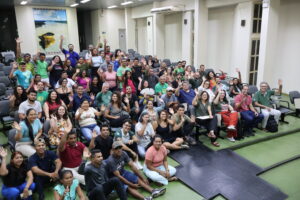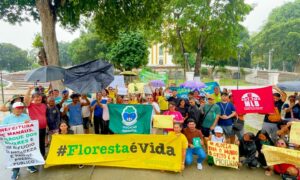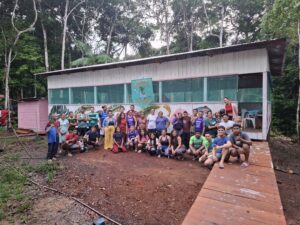For the first time, areas in the Brazilian Amazon were identified that should be prioritized for the conservation of jaguars while highlighting the fundamental role of Conservation Units and Indigenous Lands.
By Juliano Bogoni
For a jaguar to live well, an area of tens of km2 is needed, so its long-term conservation requires large-scale planning approaches that include networks of protected areas (UCs or conservation units) and corridors. This, above all, in Amazon, which is constantly shrinking, increasingly threatened by fires, hunting, and deforestation driven by livestock, agriculture, mining and infrastructure expansion. For example, landscapes dominated by grasslands pose a major threat to jaguars, as up to 150 big cats can be killed annually through bait such as poisoned carcasses and even direct pursuit by bounty hunters. These practices have become more common with the relaxation of enforcement of environmental laws during the Bolsonaro’s government.
For the first time, researchers identified protected areas in Brazilian Amazon that should be treated as a priority for the conservation of this species. The study that I led in partnership with a team of researchers, was published in Nature Journal. The study quantifies the main threats to jaguars in 447 conservation units in the Brazilian Amazon, including 330 indigenous reserves. The main threats assessed include human population density, roads, pastures, fires, deforestation, and mining areas. With this, we identified conservation units that need immediate conservation actions to safeguard jaguars, since there are large populations of the feline in places with high levels of human threat. The 447 areas analyzed add up to 1,755,637 km², which represents 41.7% of the Brazilian Amazon, and are home to 26,680 jaguars according to estimates. Indigenous reserves are home to 63.2% of the total number of jaguars in all conservation units that were analyzed. This result shows the enormous importance of traditional populations to protect Brazilian biodiversity.
Our study identified the top 10 protected areas that should be prioritized for immediate jaguar conservation efforts and 74 additional areas that should be prioritized for short-term actions. Many of them are located on the deforestation boarder or close to important borders with neighboring countries like Peru, Colombia, and Venezuela. These are the conservation units most pressured by deforestation, fires, and other imminent threats. The top-10 conservation units add up to a total of 25,254 km2 (1.5% of the total area), but can house a conservative estimate of over 3,000 jaguars. If we consider the 10 priority areas plus the 74 short-term priority areas, these 84 areas could protect more than half (53.1%) of the total jaguar population in the Amazon conservation units.
The future of jaguars, even in the most preserved regions such as Amazon, can only be guaranteed in protected areas where land use restrictions can be rigorously enforced and which can then withstand relentless political pressure to reduce, downgrade, and disqualify conservation units. Protected areas are essential to protect biodiversity, but they are under multiple geopolitical pressures and their surroundings are generally extremely degraded. Currently, the Brazilian government invests less than one dollar per km in all protected areas under state and federal jurisdiction, not including indigenous lands. With the recent elections and the change in presidency, there’s new hope for Brazilian Amazon and jaguars, thanks to a greater political will for environmental protection.
We, the authors of the study, recommend increasing funding for protected areas, especially the ones identified as high priority, as well as building a strong and integrated set of policies and legal frameworks that leave no room for reduction and downgrading of protected areas. We also suggest greater funding and support for environmental agencies such as IBAMA and ICMBio, which have suffered significant cuts in recent years, as well as adequate support for indigenous lands that strengthens the participation of indigenous peoples in the decisions and management of their territories. There are few studies about this from a biodiversity point of view. It is essential to establish participatory and robust structures for monitoring jaguars and biodiversity in these areas, encouraging local governance.
Furthermore, considering that the jaguar is a widely distributed species and vulnerable to human persecution due to livestock depredation, actions to raise awareness and mitigate conflicts between humans and jaguars within conservation units and their cushioning zones are of vital importance. With climate change worsening, fire prevention and management will also become increasingly crucial. Ultimately, conservation has no future unless local communities benefit from it; therefore, we need to continue to increase people’s perception of jaguars and forests preservation benefits. This can be done, for example, through tourism or non-timber forest products. Conserving jaguars means conserving the Amazon, which has important global benefits.






